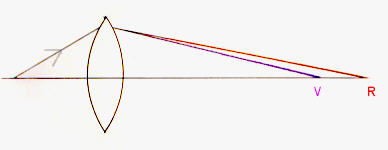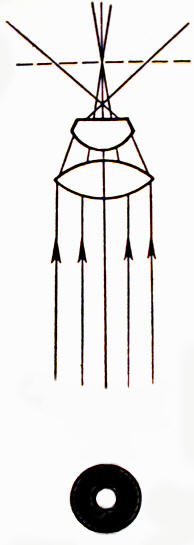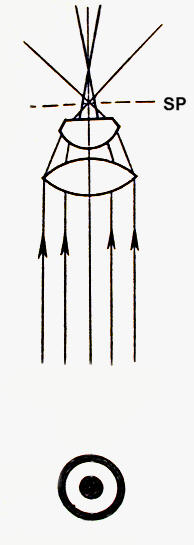 |
| COL Update Part IV: A Few Very Brief Notes By Paul James (UK) |
(COL - circular oblique illumination. Click each link for Part I, II, III.)
The improvement of an achromat's secondary chromatic aberrations
I have been constantly impressed with COL, and especially with the humble achromat: the performance of which seems to be particularly elevated in comparison to the more highly corrected fluorites and apochromats. The latter two do excel in COL's lighting setups and are still superior to the achromat, but not quite to the same relative degree as in BF.
I think the reason is that the secondary longitudinal chromatic aberration which is present in all achromats in varying degrees, is muted by the small bandwidth of light in the cross section of the annulus' ring :-
 |
Whilst the simplified diagram above grossly exaggerates the longitudinal chromatic aberration of an achromatic objective, it illustrates the fundamental principle that the red light is dispersed further along the optical axis than the violet/blue light. Since a very narrow section of the objective is actually imaging the light from the specimen, the dispersion is limited to the outer region of the lens. No central light from the objective reaches this image plane and any chromatically dispersed colour which would have added to the final image, is of course entirely absent.
In reality the image from a Tiyoda x60 achromat and that from a Wild x50 Fluorite, both of N.A.1.0 aperture were remarkably similar with the fluorite having the slightly finer image. In brightfield the difference between these two was most obvious, with higher than average axially dispersed colour from the achromat. Thus the achromat is well served in COL.
The Abbe condenser's spherical aberration
The fact that the Abbe condenser cannot provide an evenly illuminated field because of spherical aberration for the higher power objectives is illustrated below. Each of the two extremities of focus shown below, illustrate the appearance of the field in the back of the objective. It can be seen that there is no true focal point along the axis. Whilst this is undesirable for BF illumination, COL's effectiveness is unhindered because the Abbe can easily illuminate the narrow circular zone of an annulus as used in COL. All that is required is careful focussing to allow the annulus to be flooded with even light.
 |
 |
The condenser figured on the right would be required to be raised a little more to flood the annulus with light. It can be seen therefore that spherical aberration in the Abbe condenser is of no consequence when using COL.
Centration of annulus/condenser
The annulus and condenser centration to the optical axis can be performed without a phase telescope. Observation of the red and blue upper and lower cones from the Abbe condenser will allow precise centration within the field, albeit a little more slowly. Ideally these blue and red zones should coincide over the centre of the field, i.e. along the optical axis of the 'scope.
Sharpest imagery appears to be formed from the light which just hints on blue when the condenser is raised a little from the 'white field' norm. This is an area of illumination often called the 'transition zone' which ultimately leads to DF as the condenser is raised a little more.
| All comments welcome to the author Paul James |
Microscopy
UK Front Page
Micscape
Magazine
Article
Library
Please report any Web problems or offer general comments to the Micscape Editor.
Micscape is the on-line monthly magazine of the Microscopy
UK web
site at Microscopy-UK